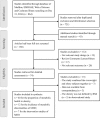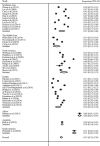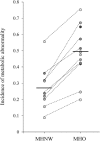The prevalence, metabolic risk and effects of lifestyle intervention for metabolically healthy obesity: a systematic review and meta-analysis: A PRISMA-compliant article
- PMID: 29381992
- PMCID: PMC5708991
- DOI: 10.1097/MD.0000000000008838
The prevalence, metabolic risk and effects of lifestyle intervention for metabolically healthy obesity: a systematic review and meta-analysis: A PRISMA-compliant article
Abstract
Background: We conducted a systematic review and meta-analysis to firstly obtain a reliable estimation of the prevalence of metabolically healthy obese (MHO) individuals in obesity, then assessed the risk of developing metabolic abnormalities (MA) among MHO individuals. At last, we evaluated the effects of traditional lifestyle interventions on metabolic level for MHO subjects.
Methods: A systematic review and meta-analysis (PRISMA) guideline were conducted, and original studies were searched up to December 31, 2016. The prevalence of MHO in obesity from each study was pooled using random effects models. The relative risks (RRs) were pooled to determine the risk of developing MA for MHO compared with metabolically healthy normal-weight (MHNW) subjects. For the meta-analysis of intervention studies, the mean difference and standardized mean differences were both estimated for each metabolic parameter within each study, and then pooled using a random-effects model.
Results: Overall, 40 population-based studies reported the prevalence of MHO in obesity, 12 cohort studies and 7 intervention studies were included in the meta-analysis. About 35.0% obese individuals were metabolically healthy in the obese subjects. There were dramatic differences in the prevalence among different areas. However, 0.49 (95% confidence intervals [CI]: 0.38 to 0.60) of the MHO individuals would develop one or more MA within 10 years. Compared with MHNW subjects, the MHO subjects presented higher risk of incident MA (pooled RR = 1.80, 95%CI: 1.53-2.11). Following intervention, there was certain and significant improvement of metabolic state for metabolically abnormal obesity (MAO) subjects. Only diastolic blood pressure had reduced for MHO individuals after intervention.
Conclusions: Almost one-third of the obese individuals are in metabolic health. However, they are still at higher risk of advancing to unhealthy state. Therefore, it is still needed to advise MHO individuals to maintain or adopt a healthy lifestyle, so as to counterbalance the adverse effects of obesity.
Copyright © 2017 The Authors. Published by Wolters Kluwer Health, Inc. All rights reserved.
Conflict of interest statement
The authors have no conflicts of interest to disclose.
Figures




References
-
- Keating C, Backholer K, Peeters A. Prevalence of overweight and obesity in children and adults. Lancet 2014;384:2107–8. - PubMed
-
- Primeau V, Coderre L, Karelis AD, et al. Characterizing the profile of obese patients who are metabolically healthy. Int J Obes (London) 2011;35:971–81. - PubMed
-
- Zheng R, Zhou D, Zhu Y. The long-term prognosis of cardiovascular disease and all-cause mortality for metabolically healthy obesity: a systematic review and meta-analysis. J Epidemiol Community Health 2016;70:1024–31. - PubMed
Publication types
MeSH terms
LinkOut - more resources
Full Text Sources
Other Literature Sources
Medical

